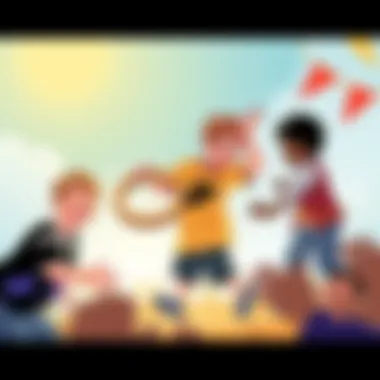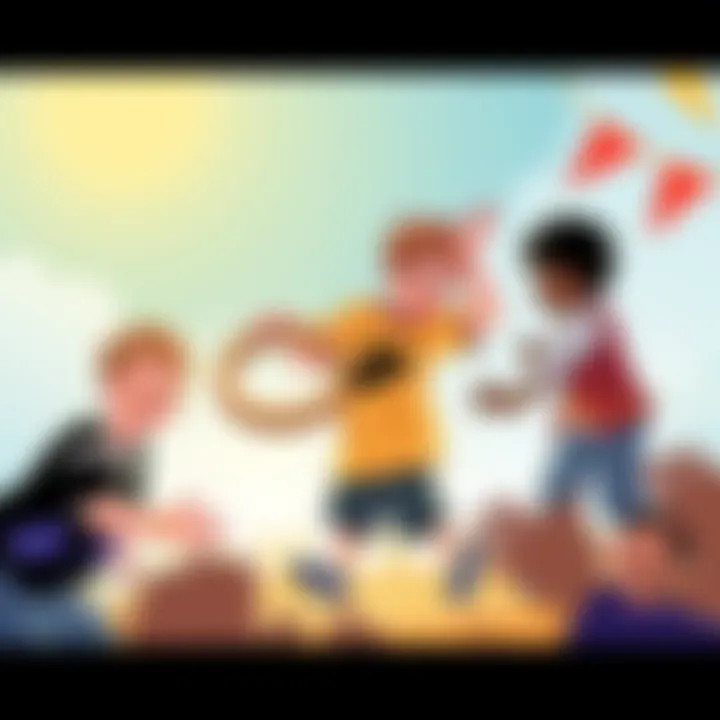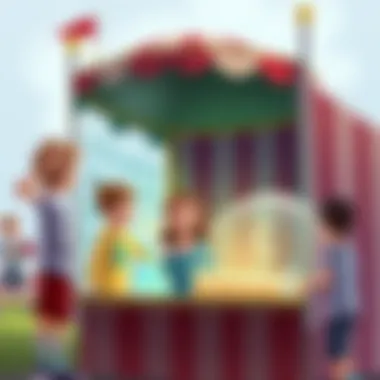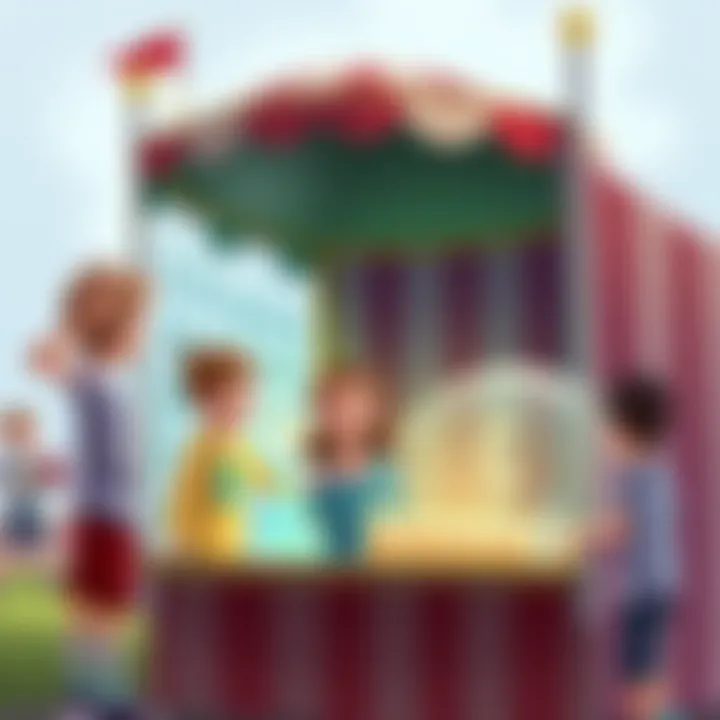Carnival Games as Tools for Learning and Fun


Intro
Carnival games have long served as a staple of fairs and festivals, enchanting people of all ages. While many see them simply as leisure activities, there's a deeper layer of learning and development embedded within these games. Punching through the façade of frivolity, we discover how simple carnival games can catalyze a child's understanding of critical concepts and enhance their social skills. It’s not just about knocking over bottles with a single toss or tossing rings onto pegs; it’s about igniting curiosity and promoting team spirit.
As we plunge into this exciting exploration, we aim to unravel the rich tapestry of simple carnival games, illustrating how they serve not only as pathways to fun but also as ingenious learning tools for kids aged six to twelve. Let’s break it down together, piece by piece, transforming what seems like mere amusement into a resourceful teaching moment.
Science Fun Facts
Simple carnival games may appear straightforward but intertwine with fascinating scientific principles. Here are some fun facts that amplify their educational importance:
- Physics in Motion: Many carnival games, like the classic ring toss or balloon darts, inherently incorporate principles of physics such as force, gravity, and trajectory. Understanding these concepts can turn a game into an engaging science lesson.
- Numbers in Fun: Games like the bean bag toss require counting and measuring distances, planting the seeds of numeracy naturally. Kids subconsciously engage in math, honing their skills while competing with friends.
"Games not only entertain but educate, laying down a foundation for real-world understanding."
- Chemistry of Colors: Some carnival setups use colored liquids or materials. Discussing why colors change or how different materials react can lead to a great hands-on science dialogue.
Discover the Wonders of Science
Introducing scientific concepts through carnival games fosters an environment ripe for curiosity. Let's unearth various subjects that can spark young minds:
- Interactive Learning Tools: Imagine using a water balloon toss to teach about proportions and phases of matter. Explain why some balloons float while others sink to merge fun with learning.
- Educational Videos and Animations: There are countless resources online where you can find engaging videos to supplement the lessons learned from carnival games. Websites such as Khan Academy or TED-Ed can provide animated explanations of foundational concepts.
- Real-Life Applications of Science: Applying knowledge gained from these games to everyday life can enhance learning. Discuss how motion and balance are essential in activities like riding a bicycle, reinforcing scientific understanding through relatable experiences.
Science Experiment Showcase
Bridging the gap between carnival fun and science can be as simple as implementing a few creative experiments:
- Fun and Engaging Experiments: For instance, constructing your version of a carnival balloon pop game could involve predicting which balloon will burst first when pressure is applied. Kids can formulate hypotheses and test them, just like a true scientist.
- Step-by-Step Instructions: Create a simple game using materials found at home, such as cups and ping pong balls for a tossing game, explaining the concepts of angles and force as they play.
- Safety Tips and Precautions: Ensure that all activities are conducted safely. Emphasize wearing safety goggles when popping balloons or handling any sharp objects.
As we draw closer to understanding the multifaceted nature of carnival games, we start to see the undeniable link between fun and foundational learning. This connection is not just a coincidence but a beautiful meeting point of leisure and education.
Preface to Carnival Games
Carnival games are more than just exciting attractions at local fairs or big gatherings; they serve as a bridge connecting entertainment with meaningful learning experiences. These games, often filled with simple yet captivating rules, provide children and adults alike with opportunities to observe, engage, and learn through play. By diving into the world of these games, we unlock a rich resource for cognitive as well as social development.
In this article, we will explore the numerous benefits that carnival games hold, especially for the younger crowd aged six to twelve. Understanding how these playful activities can sharpen skills in areas like problem-solving, teamwork, and fine motor coordination is vital. Not only do carnival games entertain, but they also cultivate essential life skills, making them a fantastic tool for both educators and caregivers.
Definition and Overview
When we talk about carnival games, we generally refer to simple competitions set up at fairs or community events, where players attempt to win prizes through skill or chance. These games can range from ring toss to balloon darts or even duck ponds. The simplicity of these games is what makes them broadly appealing; they can be easily understood and played by children as well as adults. Each game typically has a specific objective, such as knocking over bottles with a bean bag or tossing rings onto hooks, encapsulating a blend of fun, challenge, and opportunity for skill development.
The engaging nature of carnival games makes them perfect for social interaction. Imagine a group of kids huddled together, cheering each other on as they take turns. This atmosphere not only cultivates friendships but also reinforces collaborative skills as players strategize on how to win.
Historical Context
Carnival games have roots that stretch back centuries. Historically, fairs were important social gatherings where communities came together for fun, and among the key attractions were various games of chance and skill. In the past, these games were often associated with festivities and rituals, serving as a way to foster community relationships while also providing entertainment.
The evolution of carnival games can be traced back to ancient times. Games similar to our modern and practices were popular in ancient Greece and Rome during festivals. These early renditions laid the groundwork for the more structured games we see today. Over time, as traveling fairs gained popularity in the 19th century, the variety and complexity of these games expanded. Opting for vibrant designs and ever more engaging tasks, carnival games became a staple of community events, interweaving rich traditions with the maintenance of social connections.
Understanding this historical context heightens our appreciation for these games. They are not just simple forms of amusement; they are legacies that carry stories of human social interaction and cultural expression through the ages. As we explore the types and educational benefits of simple carnival games, it becomes clear that these activities have a profound impact on today’s youth, making them a valuable resource for learning.
Types of Simple Carnival Games
When you think of carnival games, a vivid image of colorful booths and laughter filled with excitement comes to mind. Simple carnival games hold a crucial role not just in entertainment but also as tools for growth and engagement. Each game serves as a microcosm of learning opportunities. From reinforcing hand-eye coordination to encouraging teamwork, these games provide experiences that cultivate both cognitive and social skill sets in children aged six to twelve. Understanding the types of carnival games can help caregivers and educators select the right activities that align with learning goals while ensuring a delightful experience for the young ones.
Ring Toss
The ring toss is a classic, often found at fairs and festivals. This game embodies a simple yet captivating principle of aiming and accuracy. Players toss rings with the objective of landing them over pegs.


Importance: The act of aiming helps in developing spatial awareness, and counting rings enhances arithmetic skills when participants track their scores. Not to mention, the thrill of trying for that elusive peg creates a sense of determination. During discussions around the game, caregivers can incorporate lessons on physics, like trajectory and how different angles affect outcomes.
Duck Pond
Duck Pond is a fun-filled game where children pick floating ducks from a small pool. Each duck may have a number or color that corresponds to a prize.
Importance: This game is excellent for teaching children about choice and consequence, a vital social skill. They learn to make decisions—selecting ducks not just based on appearances but also perceived values. Parents can extend the learning by discussing the importance of colors, shapes, and numbers, reinforcing early math concepts without pressure. Moreover, there is a lovely reality of repeating the activity, which allows kids to learn from their past choices and experiment with new tactics.
Balloon Darts
Balloon Darts can incite excitement. A player throws darts to pop balloons, often resulting in an immediate reward.
Importance: This game cultivates hand-eye coordination and fine motor skills, as it involves aim and control. Interestingly, it's also a chance to teach about pressure and volume through the popping of balloons, linking physical experience with science concepts. To extend this game educationally, caregivers might discuss why balloons pop and the materials involved, turning a playful moment into a fascinating lesson on properties of materials and safety.
Bean Bag Toss
The Bean Bag Toss, often known as cornhole, is another game that is uncomplicated yet engaging. Players toss soft bean bags into holes on an inclined surface.
Importance: This activity not only promotes physical activity but also encourages strategy and precision. While throwing bean bags, kids learn about angles, distances, and the concept of gravity in a tangible way. It's an interface of fun and learning, where players can set personal and group goals. Caregivers can also utilize this game for team-building activities. Actively engaging middle and elementary school kids helps them understand collaboration and camaraderie, making the learning experience holistic.
Carnival games possess the remarkable ability to integrate fun with fundamental educational aspects, fostering skills that stay with children long after the last ring has been tossed or balloon popped.
Integrating these games into learning environments paves a pathway for experiential learning, bridging moments of play with opportunities for skill development. As parents and educators explore various carnival games, keeping these connections in mind adds layers of value to the experience while making learning feel like a natural extension of their play.
Educational Value of Carnival Games
Carnival games often inspire joyful shouts and laughter, enjoying a moment of levity while mingling with family and friends. However, their significance goes well beyond mere entertainment. These games serve as valuable tools for education, particularly for children aged six to twelve. They stimulate various aspects of development, from cognitive abilities to social skills, while fostering motor skills and coordination. Let's delve into these elements to understand how carnival games can enrich the educational experience.
Cognitive Development
Cognitive development is a crucial aspect of childhood, encapsulating how children think, learn, and understand the world around them. Carnival games offer a colorful backdrop that encourages critical thinking and problem-solving. Take, for instance, the game of Ring Toss – it’s not merely about throwing a ring; it’s about estimating distances and angles. Kids must assess where to aim, how hard to throw, and adapt their strategies based on previous attempts. This continuous adjustment promotes their ability to think critically and make decisions.
Additionally, games like Balloon Darts engage children in basic physics concepts. For a child, popping a balloon is not just about accuracy but involves understanding force and trajectory. As they participate, they unknowingly engage their brains in mathematical and scientific reasoning, bridging fun with educational elements.
"Play is the highest form of research." - Albert Einstein
Engaging in these simple games allows kids to explore complex ideas in a safe and enjoyable environment, fostering a lifelong love for learning.
Social Skills Enhancement
Social interaction is a key component in childhood development. Carnival games create the ideal setting for children to hone their social skills. Whether they are playing alongside peers or interacting with adults, these games encourage cooperation, competition, and communication. For example, consider Duck Pond, where children often team up to strategize the best ways to win prizes.
Such interactions enable kids to practice important social skills, including:
- Taking Turns: Standing in line for a game teaches patience.
- Teamwork: Collaborating with friends to win a game cultivates a sense of community.
- Communication: Explaining strategies or cheering each other on enhances verbal skills.
Furthermore, the friendly atmosphere of carnival games fosters inclusivity. Children learn to understand different perspectives, enriching their emotional intelligence as they navigate both success and setbacks in the gaming environment. It not only prepares them for social settings outside of the carnival, such as school or community functions, but also lays the groundwork for mature social interactions later in life.
Motor Skills and Coordination
The physical demands of carnival games cannot be overlooked. They play a vital role in enhancing motor skills and coordination. Simple actions, such as tossing a ball in Balloon Darts or correctly placing a ring in Ring Toss, require focus and physical precision.
Engaging in these activities helps children improve:
- Fine Motor Skills: Handling smaller objects or coordinating fingers to grasp the ring.
- Gross Motor Skills: Developing strength and agility required to throw or jump effectively.
These games allow for continuous engagement, giving children the chance to practice and refine their skills without the pressure of a traditional learning environment. As they enjoy the carnival, they are actually working on their physical coordination, hand-eye coordination, and overall agility. This development is often far more effective in a playful setting than through structured exercises.
Incorporating Carnival Games into Learning


Carnival games are not merely about the thrill of winning a plush toy or testing one’s aim with a dart; they serve as powerful educational tools. Integrating these games into learning environments presents doorways to experiential education, allowing children to engage with concepts of science, math, and social studies in delightful ways. By incorporating carnival games into learning, we leverage hands-on activities that ignite curiosity and encourage collaboration among students, thereby enhancing the overall educational experience.
One of the most critical elements when embedding carnival games into learning is to align them with specific educational goals. This strategy can transform routine lessons into immersive activities that promote deeper understanding and retention of concepts. For instance, a simple ring toss game can teach angles and target estimation, while a balloon dart game can act as a practical demonstration of projectile motion in a physics lesson. Moreover, the fun and competitive spirit inherent in carnival games often leads to increased motivation and enthusiasm among young learners.
Moreover, incorporating these games provides an opportunity to develop essential social skills. As children participate in carnival-style games, they practice critical interpersonal skills such as teamwork, patience, and communication. They learn to handle victory with grace and defeat with resilience, both invaluable traits in their overall development.
Creating a Science-Themed Carnival
When it comes to creating a science-themed carnival, the objective is to spark interest in scientific principles through engaging activities. This can be achieved by designing games that illustrate scientific concepts in a fun and approachable manner. For example, a “Physics Fair” booth could feature a slingshot challenge, where kids calculate the optimal angle to launch a projectile to reach a target. This game could have them grappling with concepts such as force, mass, and acceleration, all under the guise of a playful challenge.
Additionally, stations can be set up for hands-on experiments disguised as carnival games. A “Volcano Eruption” booth might utilize baking soda and vinegar to create a visually appealing demonstration of chemical reactions, turning learning into an exciting spectacle. Each station must be straightforward and accompanied by simple explanations of the underlying science to keep the learning relevant.
To keep things lively and engaging, consider using colorful props, sound effects, and even costumes to bring the carnival atmosphere to life. A colorful sign proclaiming “Science is Fun!” at each booth can amplify the excitement.
Aligning Games with Educational Goals
Aligning carnival games with educational goals entails a thoughtful process that integrates curriculum objectives with activities that engage students. Here are a few steps educators can follow to achieve this alignment:
- Identify Core Concepts: Start with the curriculum framework. What subjects are currently being taught? Recognizing the key themes will allow educators to choose carnival games that complement these subjects.
- Select Appropriate Games: Choose games that can demonstrate or reinforce the identified core concepts, ensuring a clear connection between the activity and the educational goal. For example, if focusing on fractions, a Pizza Toss game where players aim to hit specific pizza slices can be both fun and instructional.
- Design Assessment Metrics: It’s vital to evaluate whether the expected learning outcomes were met. Consider using simple post-game questions or discussions to gauge understanding.
- Incorporate Reflection: After the carnival, encourage students to reflect on their experiences. What did they learn? How did the games help solidify their understanding of the concepts? This reflection can bridge the gap between play and serious learning.
The amalgamation of enjoyable carnival games and educational goals presents a unique opportunity for children to learn actively and collaboratively. This approach not only bolsters their knowledge base but also makes the learning experience memorable.
Engagement Techniques for Facilitating Learning
To truly resonate within the educational landscape, carnival games must not only entertain but actively engage the minds of young participants. These techniques are instrumental in turning a simple game into a learning opportunity. Grounded in the ideas of play-based learning, engagement techniques breathe life into the games and transform them into platforms for critical thinking and creativity. The charm of carnival games lies in their ability to foster curiosity and motivation among elementary school children, as well as create a bonding experience for parents and caregivers.
In essence, coupling fun with educational elements can maximize the learning potential of each carnival game. It’s like hitting two birds with one stone. Not only do children sharpen their skills, they also grow in confidence and social interaction. Essential elements to consider include:
- Inclusivity: Every child should find a way to participate, regardless of their skill level. Design the games with flexible rules or variations that accommodate different abilities, ensuring everyone feels like a winner.
- Interaction: Communication within the gameplay promotes teamwork and builds social skills. Encouraging comments, discussions, and collaboration enhances the experience and makes the fun communal.
- Hands-On Experiences: Children learn best when they can actually get their hands messy. Whether it’s tossing rings on pegs or tossing bean bags, the tactile aspect of the games magnifies understanding.
As game facilitators, adults play a critical role in shaping this interaction. They should not only supervise but take part, guiding children on effective strategies and introducing new concepts related to the game's theme. This supportive presence can encourage children to engage deeper with content, make connections, and develop higher-order thinking skills.
"The game is not just about winning or losing but about learning through the process of play."
Incorporating these techniques into carnival games sets the stage for a rich learning environment where children can thrive and explore.
Interactive Learning Approaches
Interactive learning approaches are vital to keeping the spirit of engagement alive. They shift the focus from passive receiving of information to active participation. Here are a few tactics to bring into the fold:
- Role-Playing: Assign different roles during games, such as players, referees, or even cheering squads. This variety keeps children entertained and encourages them to take ownership of their roles.
- Problem-Solving Elements: Incorporate puzzles or challenges within the game format. For example, in a balloon darts game, create target areas that require specific strategies to hit, prompting kids to think critically about their approach.
- Group Challenges: Encourage team-based activities where children collaborate to achieve a common goal, enhancing communication and social interaction.
These interactive approaches not only make the games more engaging but also allow for various learning styles to flourish, ensuring that every child finds a way to connect with the material.
Feedback and Motivation in Games
Feedback is the secret sauce to making any learning activity more effective. It provides children with clarity on their performance, adding a layer of motivation that can drive improvement. During carnival games, feedback can take various forms:
- Immediate Reinforcement: Giving instant feedback after each attempt, such as a high-five for trying or constructive advice on what to improve upon, reinforces positive behavior and builds confidence.
- Progress Tracking: Implement simple scoreboards or charts to visibly show progress over time. This not only motivates children but also enables them to see how they're improving, fostering a sense of achievement.
- Celebrating Efforts: Recognize participation and effort, not just the final outcome. This can be done through small rewards or acknowledgments which encourage children to engage more deeply in the learning process.
Taking the time to provide thoughtful feedback ensures that learning through carnival games is a continuous journey, one that adapts to children’s needs and celebrates their journey towards mastering new skills.
Safety Considerations in Carnival Game Activities
In any carnival setup, safety is not just an afterthought; it's a top priority. When organizing carnival games, especially those aimed at children, ensuring a safe environment is crucial. This point cannot be overstated. From the materials used in game design to proper supervision during play, each aspect contributes not only to the enjoyment of the activity but to the well-being of every participant.
Game Design and Materials


The materials chosen for carnival games play a pivotal role in safety. Here are some considerations regarding game design and materials:
- Non-toxic materials: Games should be made of substances that won’t harm children. This is particularly important as younger kids are prone to touch, lick, and sometimes even chew on things. Utilize waterproof paints and durable plastics that comply with safety regulations.
- Soft edges: Any structure that children will play with must have rounded or soft edges to prevent injuries. For example, consider using foam balls for toss games instead of harder materials that could cause bruising.
- Stability: Games need to be sturdy. If a game wobbles or can tip over easily, that creates hazards. Weighting the base of a ring toss with sand or water can keep it grounded.
By being mindful about these aspects, you ensure that the fun remains in the game without compromising on safety.
Supervision and Guidelines
When it comes to ensuring safety in carnival games, supervision is like the backbone of a good operation. Adult supervision helps immensely, especially in managing the behavior of children. Here are some guidelines to keep in mind:
- Defined play areas: Clearly marked zones for each game can help manage crowds and prevent chaotic situations. When kids know where they should be, it reduces the chances of accidents.
- Age-appropriate games: Make sure games are suitable for the target age group. For younger children, simpler tasks should be assigned, while older participants can handle more complex games. Tailoring these activities based on age myths not only promotes safety but ensures engagement.
- Clear instructions: Providing clear guidelines on how to play each game ensures that everyone is aware of the rules and objectives. This can help minimize the risk of accidents. Use simple language, and consider visual aids for younger players who may not read yet.
Remember, the goal is to create an environment where everyone feels safe to explore, learn, and have fun. Safety should never take a backseat to enjoyment.
By implementing these principles, carnival games can be a wonderful blend of fun and learning without the looming shadow of unsafe activity. Making safety a priority allows children to focus on playing, discovering, and growing.
Case Studies and Practical Examples
When we talk about simple carnival games, we aren’t just tossing rings or knocking down cans; we are diving into rich learning experiences that can shape young minds. Case studies and practical examples illuminate the real-world applications of these games, showcasing their educational benefits and how they can be woven into various settings. Understanding the efficacy of these games in educational contexts streams light on their potential impact, not only on children’s cognitive growth but also on their social development.
Successful Integration in Schools
Integrating carnival games into school curriculums can be a game changer. Take, for instance, a small elementary school in Denver that decided to introduce a science-themed carnival day. Each booth was tied to a science concept; a balloon dart game served as a lesson on air pressure, while a ring toss illustrated principles of physics like angles and gravity. The teachers cleverly designed the carnival to align with state educational standards without sacrificing the fun element.
The feedback from students was overwhelmingly positive. They reported feeling more engaged and eager to learn science when it was presented in such a playful format. Parents noticed the impact too; children were discussing what they learned at home, linking fun with educational content.
Consider the following key aspects when looking to implement such initiatives in schools:
- Curriculum Alignment: Ensure that the games support educational objectives and standards.
- Interactive Learning: Create an atmosphere where students can actively participate and experience learning rather than just passive listening.
- Assessment Opportunities: Use the carnival as an informal assessment to gauge understanding and skills in an enjoyable manner.
Community Events and Science Fairs
Community events provide an outstanding platform for showcasing carnival games paired with educational themes. Imagine a science fair in a small town where various local organizations set up interactive booths with carnival games at every corner. For example, a local library might sponsor a bean bag toss that teaches basic math skills by requiring participants to calculate the points scored during each throw.
Another illustration could be a health fair incorporating a duck pond game where attendees pick rubber ducks, each marked with food facts promoting healthy eating habits. Attendees can win small prizes while unknowingly learning about nutrition, all in a light-hearted setting. The energy at such events generates enthusiasm around learning, drawing families in and creating a unified community environment.
To enhance the experience for both adults and children in such settings, consider the following:
- Diversity in Games: Cater to different age groups by having a mix of games that challenge various skills.
- Integration of Local Knowledge: Involve local experts who can tie the games to community issues or concepts, enriching the learning experience.
- Collaboration with Schools: Work closely with local schools to present a united front in advocating for educational advancement through fun.
"Games can transform passive learning into an adventure, opening doors to a world of discovery and innovation."
Incorporating case studies and practical examples, like those mentioned, not only demonstrate the relevance of carnival games in educational settings but also highlight the dynamic and engaging opportunities they present. Looking ahead, more schools and community events might consider adopting similar models to engage students and families alike, pushing boundaries and facilitating experiential learning in new, exciting ways.
Culmination
In talking about simple carnival games, it becomes apparent that their relevance extends far beyond mere amusement. These engaging activities serve as valuable educational tools, weaving fun into the fabric of learning experiences for children. Let's delve into some key aspects regarding the importance of integrating carnival games into educational spaces.
Summary of Key Points
Simple carnival games, such as ring toss and balloon darts, not only entertain but also facilitate the development of several core skills.
- Cognitive Growth: The games challenge a child's problem-solving abilities and encourage critical thinking. Each toss or aim demands mental strategies, increasing their cognitive engagement.
- Social Skills: Participation in these games fosters social interaction, teaching kids about teamwork, competition, and communication. Playing in groups allows them to navigate social dynamics in a safe environment.
- Motor Skills: These physical activities enhance fine and gross motor skills, as children practice hand-eye coordination and precision.
Moreover, carnival games can be creatively integrated into various subject matters, like science and math, using them to elucidate complex concepts in a relatable way.
Future Directions and Implications
Looking ahead, it's crucial to consider how the simple yet effective nature of carnival games can be further harnessed in educational contexts. Educators might explore:
- Thematic Integration: Combining games with thematic learning events, such as a science fair or a math carnival, could enrich the educational experience.
- Technology and Innovation: In today's digital world, incorporating technology into these simple games could enhance engagement. Think of an augmented reality game that adds layers of learning.
- Expanded Accessibility: Ensuring these games reach diverse student populations will encourage participation from all backgrounds, promoting inclusivity in learning environments.
As carnival games continue to amuse and educate, their role in developing foundational skills in children will only grow. The blend of play with purpose holds promise not just for individual growth but fosters a community of learners ready to explore the world.







